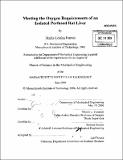| dc.contributor.advisor | Martin L. Yarmush. | en_US |
| dc.contributor.author | Izamis, Maria-Louisa, 1979- | en_US |
| dc.contributor.other | Massachusetts Institute of Technology. Dept. of Mechanical Engineering. | en_US |
| dc.date.accessioned | 2010-05-25T21:12:35Z | |
| dc.date.available | 2010-05-25T21:12:35Z | |
| dc.date.copyright | 2006 | en_US |
| dc.date.issued | 2006 | en_US |
| dc.identifier.uri | http://hdl.handle.net/1721.1/55267 | |
| dc.description | Thesis (S.M.)--Massachusetts Institute of Technology, Dept. of Mechanical Engineering, 2006. | en_US |
| dc.description | Cataloged from PDF version of thesis. | en_US |
| dc.description | Includes bibliographical references (p. 47-49). | en_US |
| dc.description.abstract | Liver perfusion systems can be used as organ culture platforms for metabolic, genetic and systems engineering, tissue regeneration, pharmacokinetics, organ storage and marginal donor reconditioning for transplantation. The primary requirement of such a system is that it maintain ex vivo organ function in a stable manner for indefinite periods of time. The more physiologically relevant the perfusion system is, the lower the likelihood of incurring functional instability, and the greater the clinical relevance of the data obtained. Currently, a major limiting factor in achieving such a design is the absence of organ-specific in vivo data to standardize, evaluate and optimize the state of perfused livers. Oxygen uptake rate, the primary indicator of organ metabolism and therefore a likely important marker of organ viability, was chosen as one such parameter to be investigated. A systematic review and reproduction of numerous oxygenation conditions cited in the literature in addition to in vivo data sampling across the rat liver shows a significant paucity of oxygen uptake in perfusion compared to in vivo. The reasons stem largely from the biological and mechanical flow properties of the perfusate, but also from the altered metabolic state of the organ in perfusion. In the absence of an oxygen carrier, the liver became oxygen starved and lost functionality. The addition of erythrocytes significantly improved oxygen delivery rates while reducing the flow rate and damaging shear stress. | en_US |
| dc.description.abstract | (cont.) However, as hematocrit approached physiological values perfusate viscosity became detrimentally high, causing severe structural and ultimately functional damage. Large strains of erythrocytes similarly impacted the liver. The addition of sodium heparin reduced erythrocyte-erythrocyte and erythrocyte-parenchyma interaction, thereby reducing sheer stress on the liver. The optimal oxygen carriers were small heparinized erythrocytes, such as goat or rat erythrocytes, at a hematocrit of 12%-20%. These conditions continued to provide adequate in vivo oxygen delivery rates and sustained organ structure and function. | en_US |
| dc.description.statementofresponsibility | by Maria-Louisa Izamis. | en_US |
| dc.format.extent | 49 p. | en_US |
| dc.language.iso | eng | en_US |
| dc.publisher | Massachusetts Institute of Technology | en_US |
| dc.rights | M.I.T. theses are protected by
copyright. They may be viewed from this source for any purpose, but
reproduction or distribution in any format is prohibited without written
permission. See provided URL for inquiries about permission. | en_US |
| dc.rights.uri | http://dspace.mit.edu/handle/1721.1/7582 | en_US |
| dc.subject | Mechanical Engineering. | en_US |
| dc.title | Meeting the oxygen requirements of an isolated perfused rat liver | en_US |
| dc.type | Thesis | en_US |
| dc.description.degree | S.M. | en_US |
| dc.contributor.department | Massachusetts Institute of Technology. Department of Mechanical Engineering | |
| dc.identifier.oclc | 613208381 | en_US |
